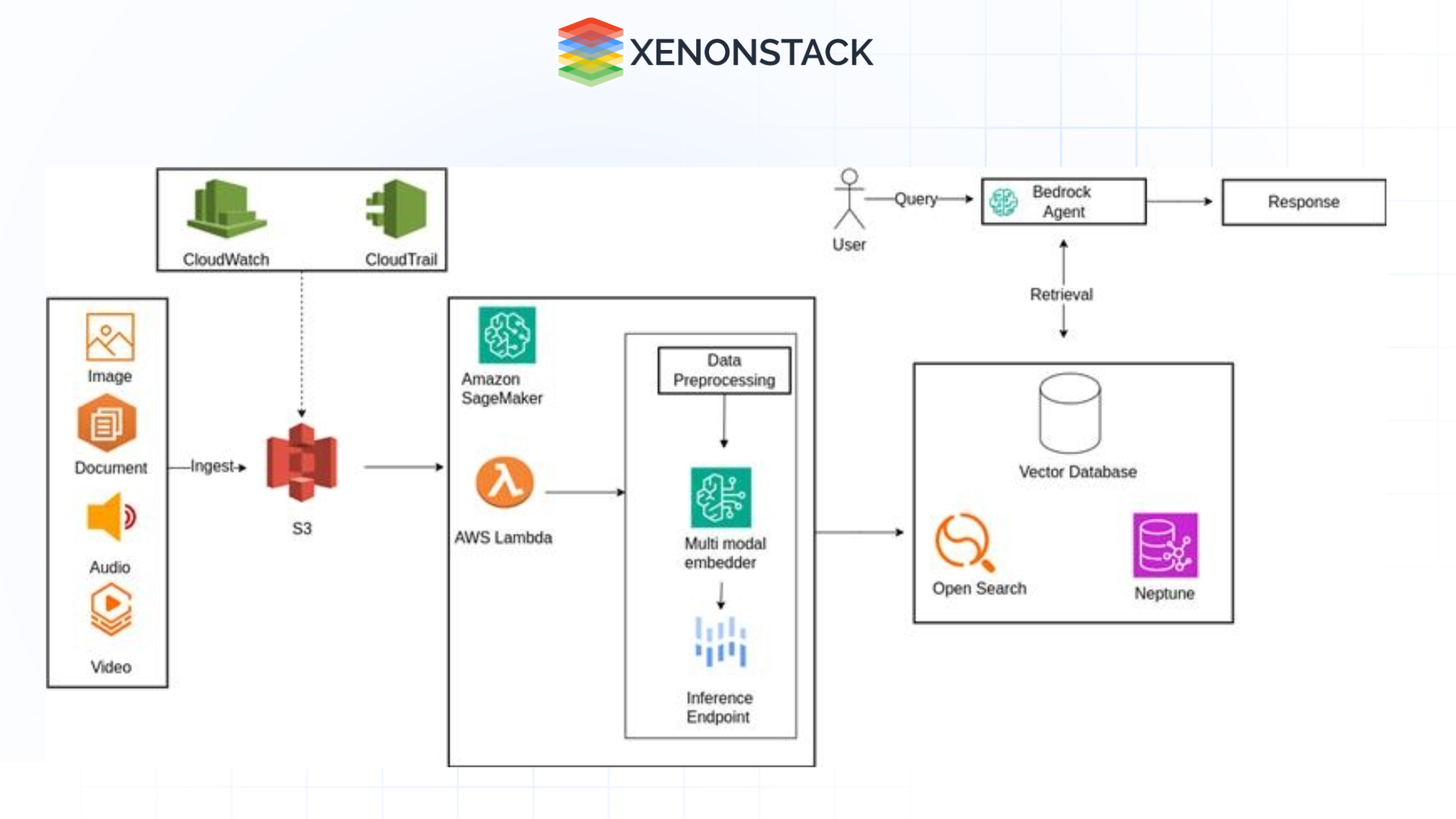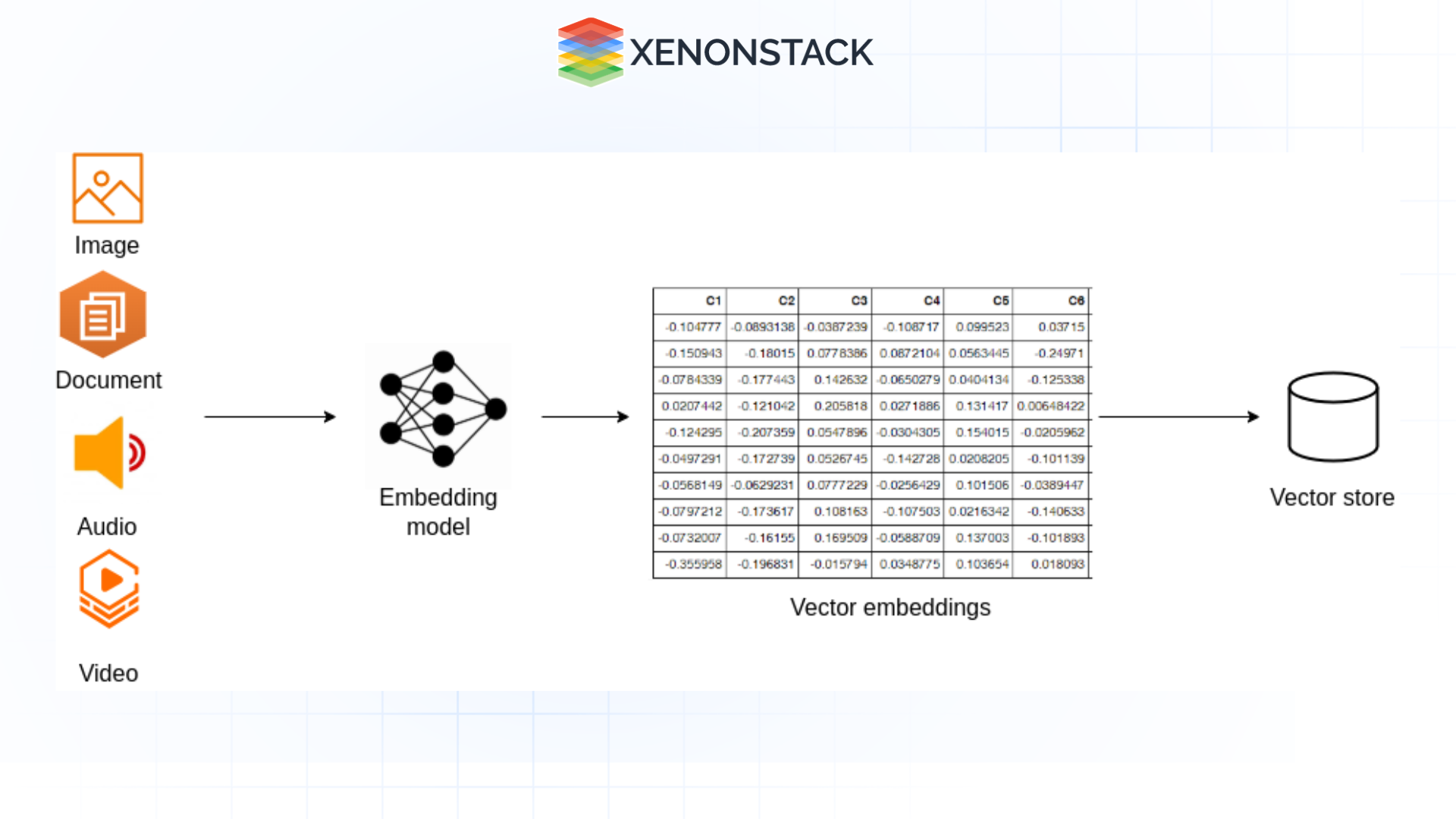Key features of SageMaker for Multimodal Embeddings include:
-
Pre-Trained Models: SageMaker JumpStart provides access to pre-trained multimodal models like the Cohere Embed Multimodal Model.
-
Custom Model Training: Users can fine-tune models using PyTorch, TensorFlow, or Hugging Face Transformers.
-
Object2Vec Algorithm: A neural embedding algorithm that generates meaningful vector representations from different input types.
-
AWS Service Integrations: Seamlessly works with Amazon S3 for data storage, DynamoDB for structured storage, and Qdrant for vector search.
-
Scalability: Supports distributed training on powerful GPU instances for handling large datasets efficiently.
Implementing Multimodal Embeddings with SageMaker
Creating multimodal embeddings—representations that integrate data from various modalities like text and images—can significantly enhance applications such as semantic search and recommendation systems. Amazon SageMaker provides a robust platform for developing and deploying these embeddings efficiently.
 Figure 2: Pipeline for multimodal embeddings
Figure 2: Pipeline for multimodal embeddings Set Up Your AWS Environment
-
Ensure you have an active AWS account with the necessary permissions to access SageMaker and related services.
-
Install the AWS Command Line Interface (CLI) and configure it with your credentials.
Choose a Multimodal Embedding Model
-
Amazon SageMaker offers pre-trained multimodal models like Cohere's Embed 3 and Amazon's Titan Multimodal Embeddings.
-
Cohere's Embed 3 can generate embeddings from text and images, facilitating seamless integration of diverse data types.
Deploy the Model on SageMaker
-
Subscribe to the desired model through the AWS Marketplace.
-
Deploy the model using SageMaker JumpStart or the SageMaker console.
-
Configure the endpoint to handle inference requests.
Prepare Your Data
-
Collect and preprocess your text and image data, ensuring it's in a format compatible with the model.
-
For images, consider encoding them in base64 format for processing.
Generate Embeddings
-
Use the deployed model endpoint to generate embeddings for your data.
-
Send the text input to the model and receive the corresponding embedding vector for text data.
-
For images, send the base64-encoded image to the model to obtain the embedding.
-
The model can generate a unified embedding for combined text and image inputs that captures information from both modalities.
Utilize the Embeddings
-
Store the generated embeddings in a vector database like Amazon OpenSearch Serverless for efficient retrieval.
-
Use these embeddings to enhance applications such as semantic search, recommendation systems, or any other application that benefits from understanding the semantic relationships between text and images.
By following these steps, you can effectively create and deploy multimodal embeddings using Amazon SageMaker, enhancing your application's ability to process and understand diverse data types.
Benefits of Using Amazon SageMaker for Multimodal Embeddings
Amazon SageMaker offers a scalable, secure, and fully managed environment for generating multimodal embeddings, making it an ideal choice for AI-driven applications. Here are some key benefits:
-
Scalability & Performance: SageMaker provides on-demand compute resources, allowing you to scale model inference dynamically based on workload demands. It supports GPUs and specialized instances to efficiently process large datasets, including high-resolution images and long text sequences.
-
Pre-Trained Models & Customization: SageMaker JumpStart offers pre-trained multimodal embedding models like Cohere Embed 3 and Amazon Titan, reducing development time. It also allows for fine-tuning models using proprietary datasets to improve accuracy and relevance for specific applications.
-
Seamless Integration with AWS Services: Easily store and retrieve embeddings using Amazon OpenSearch, DynamoDB, or S3.For enhanced functionality, combine SageMaker embeddings with AWS AI services such as Amazon Rekognition (image analysis) and Amazon Comprehend (text processing).
-
Cost Efficiency: Pay-as-you-go pricing ensures that businesses only pay for the resources they use, eliminating the need for costly infrastructure investments.SageMaker’s managed services help reduce operational overhead and maintenance costs.
-
Security & Compliance: SageMaker provides built-in security features like encryption, IAM-based access controls, and VPC integration to safeguard sensitive data. It meets industry compliance standards such as HIPAA and GDPR, making it suitable for highly regulated industries.
Practical Use Cases of Multimodal embeddings
Multimodal embeddings can drive innovation across various industries by enabling AI systems to understand and integrate diverse data formats.
E-Commerce & Retail
-
Visual Search & Recommendations: Customers can search for products using images instead of text queries. Multimodal embeddings improve recommendation systems by combining text descriptions with product images.
-
Fraud Detection: Identifies inconsistencies in user-generated content (reviews, images, receipts) by analyzing textual and visual patterns together.
Healthcare & Medical Research
-
Medical Image Analysis: Embeddings help correlate patient symptoms (text-based clinical notes) with X-rays, MRIs, or CT scans to improve disease diagnosis.
-
Drug Discovery: AI models analyze scientific literature (text) alongside molecular structures (images) to identify potential drug candidates.
Finance & Insurance
-
Automated Claims Processing: Multimodal AI can process insurance claims by extracting data from textual reports and supporting images (e.g., accident photos).
-
Fraud Prevention: Identifies fraudulent activities by cross-referencing invoice texts, customer statements, and transaction images.
Autonomous Vehicles & Smart Cities
-
Traffic Monitoring & Incident Detection: AI models process live video footage (images) along with textual traffic reports to predict congestion and accidents.
-
Smart Parking Systems: Combines license plate recognition (image data) with parking rules (text data) to optimize parking availability.
Final Thoughts on Multimodal Embeddings
Multimodal embeddings are transforming AI applications by enabling machines to understand and relate multiple data types in a unified way. Amazon SageMaker provides a powerful and scalable environment to develop these embeddings with pre-trained models, distributed training, and seamless AWS integration.
By utilising SageMaker’s multimodal embedding capabilities, organizations can improve search engines, recommendation systems, autonomous agents, and medical diagnostics, unlocking new frontiers in AI-driven applications.
.webp?width=1921&height=622&name=usecase-banner%20(1).webp)






